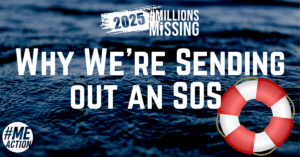The National Institutes of Health have released the results of their 1.5 day workshop on Myalgic Encephalomyelitis/Chronic Fatigue Syndrome. The full P2P workshop abstract is available online but some of the most interesting and important points are excerpted below. Leave a comment and tell us, what do you like about the report? What don’t you like?
Incidence, Prevalence, and Manifestations
There are no agreed-on variables for defining ME/CFS and no accurate ways to identify and diagnose it; as 1 speaker pointed out, the syndrome has 163 possible combinations of symptoms.
Patients with ME/CFS have neurocognitive dysfunction with abnormalities on functional magnetic resonance imaging and positron emission tomography. Strong evidence indicates that immunologic and inflammatory pathologic conditions, neurotransmitter signaling disruption, microbiome perturbation, and metabolic or mitochondrial abnormalities are potentially important for the definition and treatment of ME/CFS.
Ways to Foster Research and Enhance Development of Treatments
The following questions need to be answered: What is the pathogenesis of ME/CFS? What are the roles of virologic mechanisms, especially herpesviruses? Does mononucleosis lead to ME/CFS in adolescents? What are the roles of other pathogenic agents? Is this a genetic disease? Is there a gene–environment interaction? Is it a spectrum disease? Are different pathways responsible for different symptoms?
Future Directions and Recommendations
Overall, we have not implemented what we already know for patients with ME/CFS while the disease steals their health and well-being.
The influence of health literacy and cognitive impairment on informed consent must be considered.
The dissemination of diagnostic and therapeutic recommendations should begin by focusing on primary care providers and expand to other areas, such as neurology, rheumatology, and infectious disease.
1. Define Disease Variables
A team of stakeholders (such as patients, clinicians, researchers, and federal agencies) should be assembled to reach a consensus on the definition and variables of ME/CFS.
A national and international research network should be developed to clarify the case definition and advance the field.
2. Create New Knowledge
Developing biomarkers and diagnostic tests should be a priority.
Specific activities should focus on the following:
- Valid prognostic tests that can guide treatment strategies using genomic, epigenomic, proteomic, and metabolomic strategies to identify critical biomarkers that will be clinically applicable
- Functional magnetic resonance imaging and imaging technologies should be further studied as diagnostic tools and methods to better understand the neurologic dysfunction of ME/CFS.
- Biological samples (such as serum and saliva, RNA, DNA, whole blood or peripheral blood mononuclear cells, and tissues) and deidentified survey data should be linked in a registry or repository to understand pathogenesis and prognosis and facilitate biomarker discovery.
- Further exploration is needed of the intestinal microbiome and the effect, if any, of the environment and microbiome on ME/CFS development.
- Epidemiologic studies of ME/CFS, including incidence and prevalence, persons who are at high risk, risk factors, geographic distribution, and the identification of potential health care disparities
- Previously collected research data should be analyzed to advance knowledge and inform trial development and design and facilitate necessary clinical studies. In particular, drug therapies used for fibromyalgia or other pain-related syndromes and disorders should be examined for effectiveness in ME/CFS.
- Studies that stratify by clinical characteristics should be used to develop diagnostic and prognostic algorithms to identify who will develop ME/CFS after infection or other triggers.
- Longitudinal studies to explore the possibility of a progressive immune exhaustion or dysfunction
- Studies of identical twins to identify gene expression biomarkers are needed. Both male and female models must be used to explore the role of sex, X-chromosome genes, and hormones
- How patients’ background medications (including psychiatric drugs) affect function and outcome
- Studies investigating homeopathy, nonpharmacologic, complementary and alternative medicine treatments, and biopsychosocial variables (including the mind–body connection), function, and QoL
3. Improve Methods and Measures
The need for improved measures to identify ME/CFS while including the patient’s voice through patient-reported outcomes is critical.
Without a diagnostic test, stratification must occur to reduce and comprehend variability (such as onset, time course, and comorbid conditions) and to identify clearly defined end points for treatment trials and interventions.
Although ME/CFS is not a psychiatric disease, exploring psychiatric comorbid conditions, such as depression, anxiety, and fear, is critical to improve QoL.
Telemedicine or home visits for patients who cannot participate in clinical trials or treatment in person as well as outreach to underserved communities are needed.
4. Provide Training and Education
Many clinicians do not fully understand ME/CFS. We believe that it is a distinct disease that requires a multidisciplinary care team (such as physicians, nurses, case managers, social workers, and psychologists).
5. Finding New Funding Resources
With a relatively small number of researchers in the field and finite resources, partnerships across institutions are needed to advance the research and develop new scientists.
A network of collaborative centers working across institutions and disciplines, including clinical, biological, and social sciences, should be created.
A central archive of deidentified data and tissue samples from previous and ongoing studies to enable sharing of data and samples should be established.
6. Conduct Clinical Trials
The NIH should work with ME/CFS partners and stakeholders to create a Web site for patient and clinician educational materials as well as information about clinical trials.
Opportunities to use the NIH Clinical Center for clinical trials and fast-track testing of new therapies should also be explored.
7. Improve Treatment
Patients should be active participants in care and decision making.
The modest benefit from cognitive behavioral therapy should be studied as an adjunct to other methods.
Future treatment studies should evaluate multifaceted therapies focusing on biomedical and supportive care. Comparative effectiveness research is also needed.
We recommend that the NIH and U.S. Food and Drug Administration convene a meeting on the state of ME/CFS treatment.
Conclusions
Patients with ME/CFS want their stories to be heard, and the ME/CFS community may benefit from education on how to effectively communicate their concerns to clinicians. Clinicians could benefit from enhanced active listening skills and increased education.
Furthermore, the multiple case definitions for ME/CFS have hindered progress. In particular, continuing to use the Oxford definition may impair progress and cause harm. Therefore, for progress to occur, we recommend that this definition be retired; the ME/CFS community concur on a single case definition (even if it is not perfect); and patients, clinicians, and researchers agree on a definition for meaningful recovery.
The NIH should work with the Centers for Medicare & Medicaid Services and the Patient-Centered Outcomes Research Institute to develop demonstration projects of patient-centered medical homes for patients with ME/CFS.
We recommend that the NIH Office of Disease Prevention convene another expert panel in 5 years to monitor progress. We hope our work has dignified ME/CFS and affected persons while providing expert guidance to the NIH and the broader research community.
Did you make it all the way through? Give yourself a high five! What did you think? Tell us in the comments and then share the article on your favorite social media platform





5 thoughts on “The NIH talks ME/CFS: The P2P Workshop Report”
Dr Byron Hyde reported in 1989 that, “To my knowledge, there are only five diseases that have a pathological low sedimentation level: Myalgic Encephalomyelitis, sickle-cell anemia, hereditary sperocytosis, hyper-gammaglobulinemia and hyper-fibrogenemia.’
Thanks Pete, yes I have found that it is possible to heal yorueslf of CFS/ME and there are many others with stories to match. Of course there are also many people who have not had that same experience and I don’t wish to advocate that for everyone you can cure yorueslf. But, well, I just encourage giving it a go and seeing what happens. What have you got to lose? And you are right, I do think that for some it just gets too overwhelming and depressing and they in some way give up by hoping that someday there will be a cure developed. I just couldn’t stay in that place. It was too dark for me and I couldn’t survive there for long ..so thus I had to keep pushing forward hoping, attempting, falling, crying, nurturing, hoping, and doing it all over again. Now I can truly say it has paid off and I now hope never to take my body for granted again!
Watching both days of P2P meetings gave me hope that someone might pay attention. After 30 years of living with a diagnosis of ME (later CFS) still later acute encephalitic lyme (along with other co-morbid conditions) I had the feeling that I was living in limbo waiting for the passage of time to age and die. Not to sound dramatic, but periodically I improve sufficiently to begin to engage in professional, social, and personal activities but ultimately can not thrive and as I attempt to push through symptoms became sick once again. The obvious consequence of death is the absence of benefitting from solutions that might be forthcoming. For me, diagnosis is not the problem; I along with my classmates was diagnosed on day 1 in Hong Kong after a clinician examined our group, as well as our travel itinerary. So here I am thirty years later. I know I struggle, I was told on day 1 the name of my problem, but the medical community within the US from top to bottom failed me. Doctors I’ve seen, out side of NIH, seemed to fall into three camps. First there was the doctor that could no longer find physical evidence of infection so he helped me find a good mental health provider. Second, were the doctors that documented tell tales signs hidden in my blood profile and used me as a lab rat peeling away the layers of accumulated problems with varied, sometimes near fatal results. Third, are the doctors, the modern GPs, who usher through my semi annual exam and file my paper work into the system but say sorry there is nothing to be done; or no time or expertise to talk about this question or that article. My good fortunes was to be infected with Lyme bacteria which quickly developed an encephalitis near my brain stem. At least then, I attracted some attention. Now as I age, and new problems develop it is not the GP that first recognizes subtle change, it is the NIH researcher following the patients in her Lyme study. When my legs buckle, or my body is riddle with spasms, or my right arm becomes painful and weak, it is not the GP that addresses the injury it is the alternative medicine practicioner, physical threrapist, or a chiropractor using electrical stimulation, stretches and manipulations. The P2P meeting, I hope will change the medical community’s attitude eventually; I hope. But for me, today, I do not need a criteria, a drug, or even an understanding of why what is — is happening. What I need is a center of excellence where there is a collective experience of what helps and what does not. Thirty years is a long time for the medical community to pull down their blinds to a known problem. Maybe it is too easy to say sorry, we just do not know, there is nothing I can do…. next patient please. Equally important once the ME/CFS community concurs on a single case definition there does need to be a definition for meaningful recovery. I know first hand, I do not present with the same symptoms as I did thirty years ago, and i do not experience PEM the same way decade after decade. I do enjoy sometimes long remissions, but until I can move forward into the outside world without relapse I am not out of the woods. Further I am developing additional medical problems that are not known within my extended family so I am am glad to see the recommendation to include longitudal patient histories as part of the researchers data set.
Thank you for your work, and for this opportunity to share.
I am a patient who has had this ilnelss for 25 years. I have high titers for EBV, HHV-6, CMV, and Coxsackie. The science may eventually prove that XMRV is a very important component, but it may not. It’s too soon for me to be ready to put all my eggs in one basket and put all my hopes in the WPI. We need lots of research into all areas.The CAA may not speak for me, but neither does this petition.Please don’t just dismiss Farideh’s comment without giving it serious thought. The timing of this Petition is horrendous considering that the patient community has finally been able to establish an open dialogue with Dr. Mangan of the NIH and Dr. Unger of the CDC, both of whom appear to want better communication with the patients themselves. Opening a dialogue with the patient community already indicates that they know that the CAA doesn’t speak for the whole patient community. We should be capitalizing on this incredible opportunity instead of presenting ourselves as people who are more concerned with discrediting others than building a solid foundation to advance our cause. If we want our voices to be honored, then our voices and actions must be honorable. If a petition is to be presented, instead of it being a negative petition, why not present a petition that sets forth the needs and goals of the patient community with viable suggestions on how those goals and needs can best be attained? I would think that a knee-jerk reaction of any representative reading the current petition would be to back away so as not to become involved in the fray. We don’t want them backing away; we want them to come to the table and have discussions with us. This petition is not something that encourages them to do that. I urge you to reconsider this petition. I need answers; we all need answers. This petition, however, will only cause harm to the patients and create a delay in getting the answers we need. Please don’t do this.
you sound like a CAA spokesperson. We had a rvrioertal biomarker 20 years ago but CAA pulled the plug on that to support the CDCs deliberate failure to replicate it. CAA can’t pull the plug on XMRV so they have resorted to criticizing it. CAA is to blame for the decades of harm caused by the false name given to the disease, which they knew was the historically recognized neurological disease ME.People are questioning how they can pay for such extravagant salaries when their patient base has shrunk and they don’t have a CDC contract anymore. That they would work with the CDC against us was shameless and has some thinking they could be funded by the insurers. Questions are being asked about Pandora also for their failure to support WPI the biggest thing to ever happen to the ME patient community.@ Kathryn yes we are the voices that CAA does not want to hear. From 1988 they should have stood firm to fight for the truth about ME, first using the 1981 Ramsey criteria / 2003 CCC diagnostic criteria, educate physicians about the WHO G93.3 disease and demand that the NIAID investigate the rvrioertal cause. Instead CAA chose to help CDC brand us with CFS and that has cost us 20 years of no progress and the widespread belief accepted by the public and the media that CFS is psychological.CAA has never represented ME!
Comments are closed.